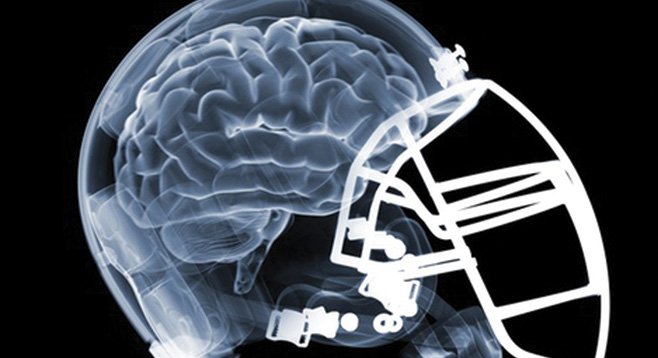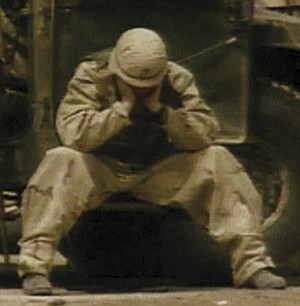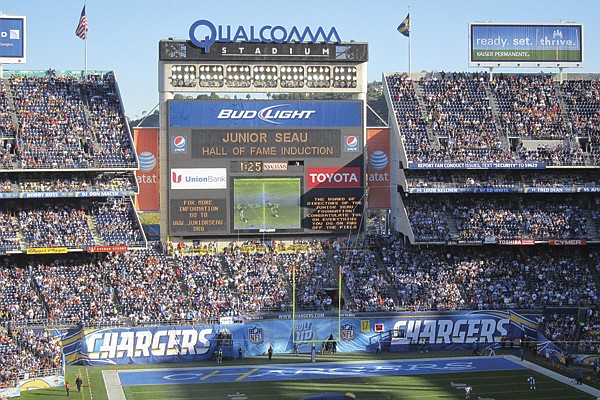 Facebook
Facebook
 X
X
 Instagram
Instagram
 TikTok
TikTok
 Youtube
Youtube

Military combat personnel in the Iraq and Afghanistan wars may suffer the same kind of brain damage as professional athletes, according to a scientific paper published last month. The finding could have a profound effect on American culture, and particularly on San Diego, where direct and indirect military spending is one-fifth of the economy and the professional football team — backed by downtown boosters — wants a massive taxpayer subsidy for a new stadium.
The study, spearheaded by researchers at Boston University, concluded that combat veterans who endured big explosions may wind up with the same degenerative brain disease as football players who are damaged by multiple concussions resulting from repetitive hits.
This is important because the brain damage suffered by participants in football, hockey, and boxing, chronic traumatic encephalopathy (called CTE), is incurable and can be detected only after the victim’s death.

Combat veterans are frequently treated for post-traumatic stress disorder (called PTSD), and in some cases for traumatic brain injury, but this new study suggests that some suffer the irreversible effects of abnormal protein deposits in the brain, as athletes do. Scientists agree more studies are needed.
If verified by other scientific probes, the results of this study may have enormous economic and societal repercussions because the Pentagon and the National Football League, in particular, have been scandalously slow to realize the importance of brain injuries.
ProPublica and National Public Radio have been exposing the Pentagon’s gross neglect of head injuries. They report that more than 115,000 warriors have sustained concussions in Iraq and Afghanistan, but the military has dragged its feet providing cognitive rehabilitation therapy to troops. Since 2002, more than half of Iraq and Afghanistan veterans treated at Department of Veterans Affairs hospitals have been diagnosed, at least preliminarily, with mental health problems, according to ProPublica.
The military reports that more troops are committing suicide than are being killed in battle — 154, or almost one a day, thus far this year.Post-traumatic stress disorder has afflicted 11 to 20 percent of Iraq and Afghanistan veterans, and since the turn of the century, more than 200,000 soldiers have been diagnosed with traumatic brain injury.
As citizens learn that a significant percentage of these brain injuries could be irreversible, the public might demand that more money go to treat returning brain-injured service personnel. There could be other additional defense expenditures, such as new kinds of training and equipment design. In the extreme case, as the public learns more about combat risks, the military may not be able to recruit enough personnel to fight the kinds of wars it now rushes into.

The risks to football at all levels — Pop Warner, high school, college, professional — are palpable. It seems impossible that football could lose its fan support. The National Football League has revenues of about $10 billion a year — far higher than teams in other pro sports. The average team is worth more than $1 billion — almost double the value of the average Major League Baseball team.
Average pro football attendance of 67,000 per game swamps other sports. The National Football League utterly dominates television revenue; more people watch the Super Bowl annually than any other program. At least $90 million is wagered legally on the Super Bowl each year and possibly $10 billion illegally through bookies, office pools, and the like.
How could a sport so deeply inculcated in our culture lose its grip on the public? It has happened before. Fifty years ago, professional boxing was a major sport and almost everyone knew the name of the heavyweight champion of the world. Question: who is it now? I’ll bet you have no idea. (Russian Alexander Povetkin is the champion of the World Boxing Association, the oldest of four major prizefight sanctioning bodies. Since 2005, the heavyweight champions have overwhelmingly been from Russia, Uzbekistan, Belarus, and Ukraine.)
Football could be gang-tackled by lawsuits. As chronic traumatic encephalopathy shows up in more high schools and colleges, insurance companies could become reluctant to provide coverage, which is already expensive. High school and college leagues could fold, although the process would almost surely be a slow-moving one. Sixty years ago, few thought that cancer-related lawsuits would cripple the domestic tobacco industry and smoking would decline sharply.
More than 2000 former professional football players have filed a consolidated suit against the National Football League and suppliers such as helmet maker Riddell Sports. Many injured retired players blame the National Football League Players Association, which, they claim, in labor negotiations has emphasized compensation of current players while shortchanging retired players.
“The concussion issue, if not handled right, has the potential to end football,” says former pro player Dave Pear. Through davepear.com/blog/, he fights for rights of retired players. Later in life, many suffer increasing symptoms of depression, insomnia, and dementia that they believe are tied to head injuries suffered in their playing days. Several have committed suicide; one left instructions that his brain should be examined.
Today’s pro players have independent neurologists on the sidelines, and concussed players can’t return to a game without expert clearance. Decades ago, the surfaces (such as AstroTurf) were harder and the equipment less reliable.
The suicide of San Diego icon Junior Seau — not yet tied to a head injury — brought commentary to Pear’s blog. Said a former Pittsburgh Steelers star, “We may never know what was going through Junior Seau’s mind. I have yet to entertain the thought of taking my life,” but he loads up on oxycodone and methadone daily, and “sometimes the pain overtakes me.” Another player wrote that he detoxed from his daily oxycodone dose. “I think of suicide almost daily,” he wrote.
That kind of talk could impress a jury.


Military combat personnel in the Iraq and Afghanistan wars may suffer the same kind of brain damage as professional athletes, according to a scientific paper published last month. The finding could have a profound effect on American culture, and particularly on San Diego, where direct and indirect military spending is one-fifth of the economy and the professional football team — backed by downtown boosters — wants a massive taxpayer subsidy for a new stadium.
The study, spearheaded by researchers at Boston University, concluded that combat veterans who endured big explosions may wind up with the same degenerative brain disease as football players who are damaged by multiple concussions resulting from repetitive hits.
This is important because the brain damage suffered by participants in football, hockey, and boxing, chronic traumatic encephalopathy (called CTE), is incurable and can be detected only after the victim’s death.

Combat veterans are frequently treated for post-traumatic stress disorder (called PTSD), and in some cases for traumatic brain injury, but this new study suggests that some suffer the irreversible effects of abnormal protein deposits in the brain, as athletes do. Scientists agree more studies are needed.
If verified by other scientific probes, the results of this study may have enormous economic and societal repercussions because the Pentagon and the National Football League, in particular, have been scandalously slow to realize the importance of brain injuries.
ProPublica and National Public Radio have been exposing the Pentagon’s gross neglect of head injuries. They report that more than 115,000 warriors have sustained concussions in Iraq and Afghanistan, but the military has dragged its feet providing cognitive rehabilitation therapy to troops. Since 2002, more than half of Iraq and Afghanistan veterans treated at Department of Veterans Affairs hospitals have been diagnosed, at least preliminarily, with mental health problems, according to ProPublica.
The military reports that more troops are committing suicide than are being killed in battle — 154, or almost one a day, thus far this year.Post-traumatic stress disorder has afflicted 11 to 20 percent of Iraq and Afghanistan veterans, and since the turn of the century, more than 200,000 soldiers have been diagnosed with traumatic brain injury.
As citizens learn that a significant percentage of these brain injuries could be irreversible, the public might demand that more money go to treat returning brain-injured service personnel. There could be other additional defense expenditures, such as new kinds of training and equipment design. In the extreme case, as the public learns more about combat risks, the military may not be able to recruit enough personnel to fight the kinds of wars it now rushes into.

The risks to football at all levels — Pop Warner, high school, college, professional — are palpable. It seems impossible that football could lose its fan support. The National Football League has revenues of about $10 billion a year — far higher than teams in other pro sports. The average team is worth more than $1 billion — almost double the value of the average Major League Baseball team.
Average pro football attendance of 67,000 per game swamps other sports. The National Football League utterly dominates television revenue; more people watch the Super Bowl annually than any other program. At least $90 million is wagered legally on the Super Bowl each year and possibly $10 billion illegally through bookies, office pools, and the like.
How could a sport so deeply inculcated in our culture lose its grip on the public? It has happened before. Fifty years ago, professional boxing was a major sport and almost everyone knew the name of the heavyweight champion of the world. Question: who is it now? I’ll bet you have no idea. (Russian Alexander Povetkin is the champion of the World Boxing Association, the oldest of four major prizefight sanctioning bodies. Since 2005, the heavyweight champions have overwhelmingly been from Russia, Uzbekistan, Belarus, and Ukraine.)
Football could be gang-tackled by lawsuits. As chronic traumatic encephalopathy shows up in more high schools and colleges, insurance companies could become reluctant to provide coverage, which is already expensive. High school and college leagues could fold, although the process would almost surely be a slow-moving one. Sixty years ago, few thought that cancer-related lawsuits would cripple the domestic tobacco industry and smoking would decline sharply.
More than 2000 former professional football players have filed a consolidated suit against the National Football League and suppliers such as helmet maker Riddell Sports. Many injured retired players blame the National Football League Players Association, which, they claim, in labor negotiations has emphasized compensation of current players while shortchanging retired players.
“The concussion issue, if not handled right, has the potential to end football,” says former pro player Dave Pear. Through davepear.com/blog/, he fights for rights of retired players. Later in life, many suffer increasing symptoms of depression, insomnia, and dementia that they believe are tied to head injuries suffered in their playing days. Several have committed suicide; one left instructions that his brain should be examined.
Today’s pro players have independent neurologists on the sidelines, and concussed players can’t return to a game without expert clearance. Decades ago, the surfaces (such as AstroTurf) were harder and the equipment less reliable.
The suicide of San Diego icon Junior Seau — not yet tied to a head injury — brought commentary to Pear’s blog. Said a former Pittsburgh Steelers star, “We may never know what was going through Junior Seau’s mind. I have yet to entertain the thought of taking my life,” but he loads up on oxycodone and methadone daily, and “sometimes the pain overtakes me.” Another player wrote that he detoxed from his daily oxycodone dose. “I think of suicide almost daily,” he wrote.
That kind of talk could impress a jury.
Comments